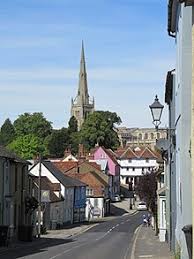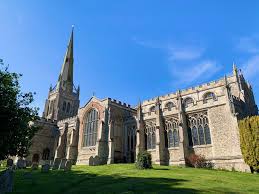 To be honest, we have probably swept the stove chimney in the vicarage at Thaxted more times than any other vicarage across the whole of Essex. Like at Saffron Walden Thaxted Vicarage is some distance from the church, located as it is down Watling Lane, but following the recent trend, it is quite a modern house, specifically built for the purpose. But it is the church of Saint John the Baptist with Our Lady and Saint Laurence which is a jewel of medieval gothic church building.
To be honest, we have probably swept the stove chimney in the vicarage at Thaxted more times than any other vicarage across the whole of Essex. Like at Saffron Walden Thaxted Vicarage is some distance from the church, located as it is down Watling Lane, but following the recent trend, it is quite a modern house, specifically built for the purpose. But it is the church of Saint John the Baptist with Our Lady and Saint Laurence which is a jewel of medieval gothic church building.
There has been a Christian church in Thaxted since Saxon times. The first documented reference to a church in the settlement is in the Liber Eliensis, regarding a gift of land in “Thacstede” to the abbey at Ely by a woman named Æthelgifu sometime between 981 and 1016. It states that the will, written in English, was kept in the church there as evidence. An early church was said to have been dedicated to Saint Catherine and its foundations were reportedly found in the eighteenth century at Rails Farm, not far from the present church site. There is also evidence that the current building stands on the site of an earlier church, and that traces of this church were found under the chancel.
Why a modest settlement such as Thaxted in the fourteenth century should have embarked upon building such a grandiose structure has long been a matter of debate and conjecture. A number of factors may have played a part: a dispute between the vicar and the monks of Tilty Abbey over tithes allowed the considerable sums previously donated to the abbey by the town to be diverted to the parish church, at a time when the town was beginning to prosper as a centre of the cutlery industry. The inhabitants were therefore able to organise and contribute towards the financing of a major church building project, even if the support of rich benefactors was still necessary. During the period when construction began, many small donations of land were made to the borough, which were immediately sold, presumably for the purpose of funding the new structure. The appointment of four churchwardens is taken as an indication that the town was managing funds for construction.
The construction was sponsored by a number of noble patrons descended from the Clare family who had held the manor of Thaxted since the Norman Conquest: Elizabeth, Lady Clare (1295–1360); Lionel, Duke of Clarence (1338–68); Edmund Mortimer, 3rd Earl of March (1352–81); his grandson, Edmund Mortimer, 5th Earl of March (1391–1425); and King Edward IV (1442–83).
The current church was built over an extended period from the mid-fourteenth century to the first quarter of the sixteenth century, probably on the site of an earlier church. The earliest parts of the present building date from c. 1340 and substantial building works were completed by c.1510. Foundations of the earlier structure were apparently discovered under the entrance to the Chancel. Some have theorized that these remains, and the late construction of the Chancel, show that the older building remained in place until most of the new structure had been completed.




 My name is Paddy McKeown, I am a retired police officer (Detective Sergeant – Metropolitan Police), turned chimney sweep. I have completed training with ‘The Guild of Master Chimney Sweeps’, and Rod Tech UK (Power Sweeping).
My name is Paddy McKeown, I am a retired police officer (Detective Sergeant – Metropolitan Police), turned chimney sweep. I have completed training with ‘The Guild of Master Chimney Sweeps’, and Rod Tech UK (Power Sweeping).




Comments are closed.